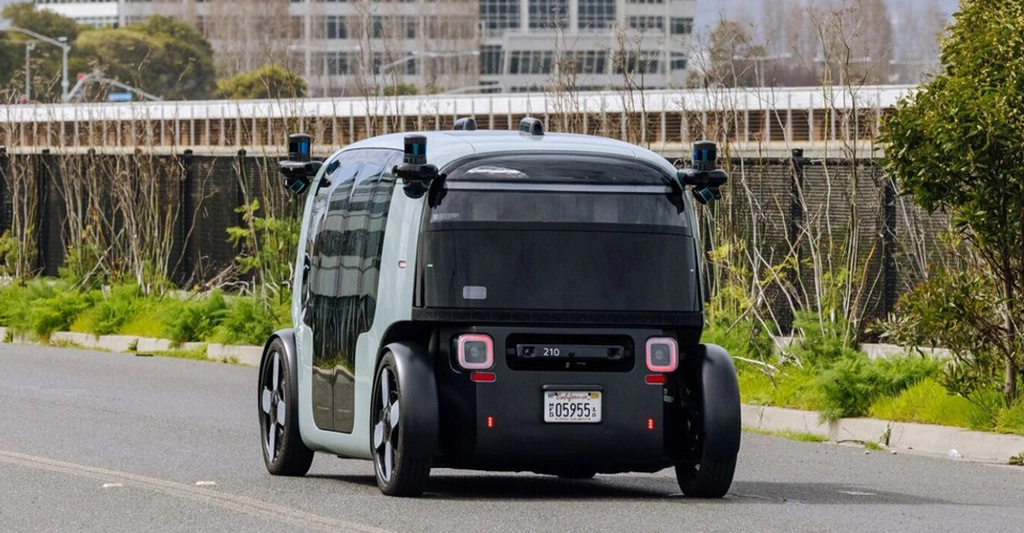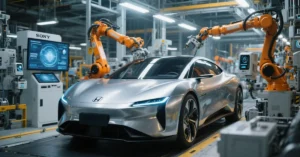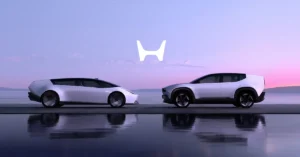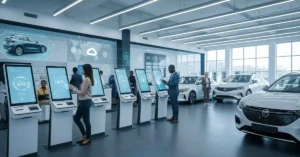Image Source: About Amazon
The world of mobility is undergoing a radical shift, and Amazon’s Zoox is at the forefront. With the launch of its purpose-built, steering wheel-free robotaxi and a production facility capable of building 10,000 units per year, Zoox isn’t just playing catch-up with Tesla or Waymo it’s setting the stage for a new era of autonomous transport.
But what does this mean for everyday commuters, urban planning, and the global race toward safer, smarter cities? Let’s break it down.
A New Breed of Robotaxi: Built from the Ground Up
Unlike many autonomous vehicle (AV) competitors retrofitting existing cars with self-driving tech, Zoox started with a blank sheet. The result? A compact, symmetrical vehicle with no steering wheel, pedals, or even a “driver’s seat.”
Instead, the Zoox pod features:
- Four-wheel steering and bidirectional driving
- Sliding doors on both sides for safer urban pickups
- Lounge-style seating where passengers face one another
- Advanced sensor arrays including lidar, radar, and multiple cameras
This design isn’t just futuristic it’s practical. It allows the vehicle to operate efficiently in dense, traffic-heavy city centres where space and visibility are limited.
Zoox vs. the Competition: What Makes It Different?
Let’s compare Zoox to its most talked-about competitors:
- Waymo uses modified Jaguars and Chryslers equipped with its autonomous tech. These vehicles still have pedals and steering wheels.
- Tesla relies solely on camera-based vision and artificial intelligence no lidar and continues to promise full self-driving capabilities in the near future, though its approach remains controversial.
- Zoox blends the safety redundancy of lidar/radar with a fully purpose-built vehicle, positioning it as a complete end-to-end operator from manufacturing to ride-hailing.
By owning every part of the ecosystem, Zoox claims it can control quality, accelerate innovation, and reduce costs over time.
Real-World Rides: What It’s Like Inside a Zoox
Test riders who’ve experienced Zoox describe it as more of a “mobile lounge” than a traditional taxi. Here’s what you can expect as a rider:
- Soft bench-style seating for up to four people
- Climate controls and charging ports for each passenger
- A central touchscreen to control music, navigation, and ride functions
- Automatic doors and seamless boarding from either side
- A smooth, calm driving experience that obeys traffic rules and handles city navigation effortlessly
The experience aims to be not just functional but comfortable no awkward chit-chat with drivers, no need to fumble with payment, and no stress in heavy traffic.
How Safe Are Robotaxis, really?
Autonomous vehicles are designed to reduce human error the leading cause of road accidents globally. But skepticism still lingers, and for good reason. Human drivers can go hundreds of thousands of kilometres before a fatal crash, and robotaxis need to prove they can do better.
So far:
- Waymo has logged over 114 million kilometres (as of early 2025) in fully autonomous mode.
- Zoox is beginning public trials in Las Vegas and San Francisco.
- Most AV developers agree: it will take billions of kilometres across diverse environments not just sunny suburbs to truly validate safety.
Zoox, like others in the industry, uses redundant systems and rigorous quality checks including real-world test tracks at its new California factory to ensure its robotaxis behave predictably.
The Bigger Picture: Urban Impact and Sustainability
Autonomous, electric ride-sharing fleets like Zoox aim to reduce traffic congestion, lower emissions, and eliminate the need for personal car ownership in urban areas. If widely adopted, they could help:
- Reduce the number of cars on the road
- Lower city noise and air pollution
- Free up parking spaces for green zones or housing
- Improve mobility for people who can’t drive
Each Zoox robotaxi is fully electric and part of Amazon’s broader push toward sustainability, including its commitment to reach net-zero carbon by 2040.
Barriers to Adoption: It’s Not All Smooth Roads Ahead
Despite the tech buzz, several challenges remain:
- Regulation: Autonomous vehicles must navigate different rules across cities and countries.
- Public Trust: Many people still feel uneasy about getting into a vehicle with no driver.
- Infrastructure: Cities need smart traffic systems, curbside zones, and connectivity to support AVs.
- Cost: While scalable long-term, initial development and deployment are expensive.
And while Zoox is vertically integrated, it still faces stiff competition from legacy automakers, tech giants, and smaller, agile startups.
What’s Next for Zoox?
For now, Zoox’s fleet is operating within limited areas and for internal users. But public rides are expected to begin soon in Las Vegas and parts of California.
If early trials go well, we may soon see Zoox vehicles rolling out in more cities, reshaping how we think about transport.
And they won’t be alone with Tesla’s robotaxi reveal expected soon and Waymo continuing to scale, the 2020s could become the decade of driverless ride-hailing.
Final Thoughts: Are We Ready for a Driverless Future?
The technology is coming fast. What matters now is how cities, regulators, and everyday people adapt. From commuting to delivery services and emergency transport, autonomous vehicles will likely touch every corner of modern life.
Amazon’s Zoox might not be the first to market, but its radical rethinking of what a “car” should be may just make it the most disruptive.
Whether you’re a fleet manager exploring sustainable transport or a city planner preparing for the next big mobility shift, now is the time to start thinking about how this fits into your world.
Want to Stay Ahead of the Automotive Curve?
MotorHub brings you the latest insights, services, and expert resources to keep you prepared for the road ahead. Whether you’re managing EV fleets or planning your next autonomous investment, trust MotorHub to guide you through the transition.



